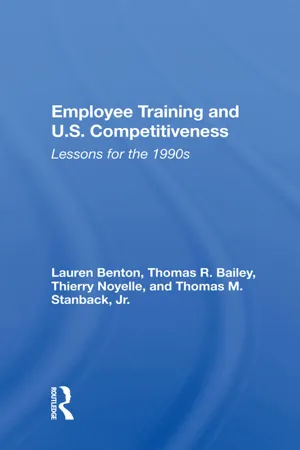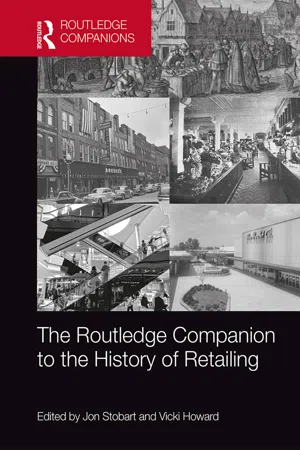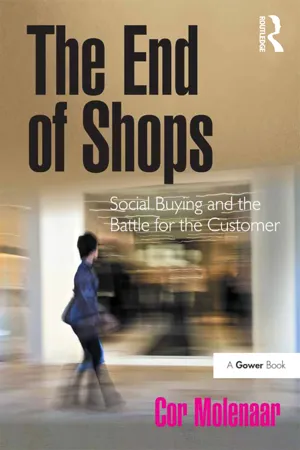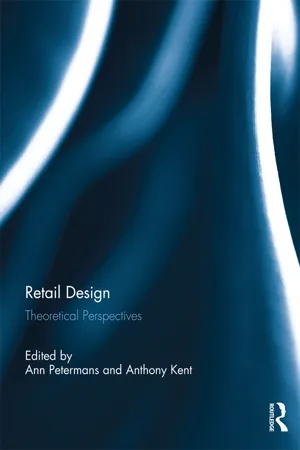Retail Trends
Retail trends encompass the evolving patterns and shifts in consumer behavior, technology, and business strategies within the retail industry. These trends often reflect changes in shopping preferences, such as the rise of e-commerce and omnichannel retailing, as well as advancements in personalized marketing, sustainability, and experiential retail. Staying attuned to these trends is crucial for businesses to adapt and thrive in the competitive retail landscape.
7 Key excerpts on "Retail Trends"
- eBook - ePub
- Tony Hines, Margaret Bruce(Authors)
- 2007(Publication Date)
- Routledge(Publisher)
...(1997) pointed out in a telling article, ‘retail renewal’ has become the critical issue of the decade. It is an indictment of the past performance of retail marketers, supposedly the customer’s champion, that it is only now that some enlightened top managements have decided to truly focus on their customers that these issues have begun to be addressed. What these companies are doing will form the subject of the next section of this chapter. Current retail initiatives The pace of change in the UK retail sector continues to increase. Acquisitions, mergers, new ventures and bankruptcies are reported weekly. The UK is the target of a constant stream of new entrants from overseas, and our own retailers, with very mixed results, continue to expand into new territories. The small band of experienced senior retail executives continue to play musical chairs, and attempts to supplement their numbers from abroad, particularly America, have been largely unsuccessful. Analysis of these trends is outside the scope of this chapter, but from them is emerging, not only in the UK but in most markets, a radical new picture of how retailing will look as this century unfolds. For the present, this emerging picture is often described as being ‘customer driven’ or ‘customer focused’, but in truth, what we are witnessing is a major shift in power away from conventional retailers in favour of the final consumer. Clearly, this will impact the very nature of ‘retail marketing’. Retailers are responding to the new consumer at five levels: Corporate culture. Retail organization and management. Retail offer or ‘proposition’. Means of delivery or executing this offer. Communications. Culture Marketing Week ’s citation for Tesco, winner of their 1996 ‘Brand of the Year’, stated that ‘the real lesson in Tesco’s transformation over the past 10 years is that a company can change its culture’ (Marketing Week, 1997)...
- eBook - ePub
Employee Training And U.s. Competitiveness
Lessons For The 1990s
- Lauren Benton(Author)
- 2019(Publication Date)
- Routledge(Publisher)
...4 The Retailing Industry The retailing sector has been profoundly affected by broad changes in the world economy since 1975. The nature of competition has changed, and new types of retailers and products have appeared to fill increasingly diverse market niches. In the process, firms have altered the way they recruit and use labor, from management levels to the lowest-level store positions. These changes are significant because they affect a large segment of the labor force: Retailing accounted for 17 percent of all nonagricultural jobs in 1987; it is the largest employer of young workers and a major employer of women. This chapter outlines the broad trends affecting retailing strategies since the late 1970s and analyzes their implications for firm-based training. An overview of trends in marketing and subsector restructuring is followed by a discussion of employment and training strategies. 1 Retailing has relied extensively on organizational transformation, changing recruitment strategies, and a new emphasis on training to adjust to the new marketplace. A detailed look at recruitment and training in one firm at the end of this chapter will help bring these points into sharper focus. The Changing Competitive Environment and New Modes of Retailing Retailing has been dramatically affected by the changing consumption patterns described in the first part of this book. Market segmentation and differentiation, together with other trends such as the aging of the baby boomers and an increase in two-earner families, have not only made traditional markets more varied but have opened vast new markets that also tend to be highly volatile. Thus, the burgeoning demand for work and leisure apparel, quickly prepared food, and home furnishings, to name just a few examples, illustrates highly fragmented demand for products catering to different tastes and budgets. As the number and variety of products have increased, so has competition for shelf space in stores...
- Jon Stobart, Vicki Howard, Jon Stobart, Vicki Howard(Authors)
- 2018(Publication Date)
- Routledge(Publisher)
...1 Introduction Global perspectives on retailing I. Introduction The digital age has severed retail’s historic ties to geography and place. Shoppers have turned to their smart phones and computers to purchase everyday items like food and clothing as well as luxury goods and personal services. Internet commerce is now a global challenge to the so-called brick-and-mortar retailer. On both sides of the Atlantic, historic retail firms have gone under, whilst many others are struggling to compete in the new environment. By many accounts, the High Street is in crisis in the United Kingdom, indicated by declining footfall of shoppers in central business districts and by store closures. Concerns over the displacement of the High Street economy in the UK have spurred numerous studies and hopeful plans for redevelopment (Portas, 2011; Wrigley, 2015). In the United States, a country with much more retail space per person than Europe, “dead malls” have become a well-known phenomenon (Europe’s Retail Market, 2017). Although a global trend, e-commerce has diffused across national markets in varying degrees: in the United States, it hovered between 9% and 10% of total retail sales in 2017; Great Britain saw online sales hit 16.5% of total retail sales in January 2018, yet China dwarfed this, accounting for 40% of total e-commerce spending globally. Every nation has experienced growth and disruption in this sector, signalling another retail revolution is upon us (Statistical Bulletin, 2018; Quarterly Retail, 2018). While the future is not foreseeable, it is safe to say that recent trends are unprecedented in their global reach. Industry observers have described a “retail apocalypse”, seeing the end of traditional face-to-face modes of selling in a physical setting. The rise of e-commerce, which is less labour intensive by nature, has negatively affected retail employment opportunities as well...
- eBook - ePub
The End of Shops
Social Buying and the Battle for the Customer
- Cor Molenaar(Author)
- 2016(Publication Date)
- Routledge(Publisher)
...5 Technology and Retail: In Times of Change You Have to Get to Know Your Customers DOI: 10.4324/9781315616070-5 Retailing has traditionally been a concept involving sound buying policy, good business premises and finding the right (sales) location. With its origins in the mobile retailing trade of the Middle Ages, 1 this developed into the shops of the nineteenth century and finally converged into department stores and shopping streets at the start of the twentieth century. The latter phase, now only 40 years old, involved a concentration of shops into shopping centres with pedestrianised areas. Retail is constantly evolving into new concepts in order to attract customers and to supply products that the customers want. After all, if the customer has no interest, the shop will not sell anything. It’s as simple as that. 1 For a more detailed description of the history of retailing, read Gartmayr Eduard, Nicht für den gewinn allein, 1964, Frankfurt aM: Verlag für Wirtschaftspraxis GmbH. Development of Technology in Retail Technology was not originally part of retailing. It was only when the electronic till was introduced that the retailer came into contact with technology. As with most innovations, the first phase in the application of technology is aimed at efficiency. This was no different with retail. The electronic till enabled sales transactions to be carried out more quickly and efficiently. Later the bookkeeping became automated, which was then followed by sales automation with the introduction of the bar code. At the same time (at the end of the 1980s), the purchasing process also changed due to the application of EDI (Electronic Data Interchange) and a unique article coding (the unique article number EAN). Thanks to EDI, other kinds of relationships developed between retailers and suppliers, and a more efficient stock control was made possible. A good coordination between systems, shop and supplier was necessary for this...
- eBook - ePub
Retail Design
Theoretical Perspectives
- Ann Petermans, Anthony Kent, Ann Petermans, Anthony Kent(Authors)
- 2016(Publication Date)
- Routledge(Publisher)
...2 Retail design A contextual lens Ann Petermans and Anthony Kent Introduction While the practices of retail design have been discussed and illustrated in some detail, the theoretical perspectives of retail design deserve fuller consideration. The efficiency and functionality of modernism in retailing have been challenged by postmodernist design, and both continue to make distinctive contributions to the industry, consumers and society. In addition they are moderated and adapted as other influences, notably sustainable and participatory design practices, become more prominent. This chapter discusses how retail design reflects the time or decade in which it is created. In particular, the authors focus on the importance of context as a driver for the development of retail design. Retail design fundamentally concerns the physical space in which goods are sold and increasingly requires a broad understanding of what creates a unique retailing experience. For brands in particular, retail provides one of the most challenging encounters producers will have with their consumers. The retail outlet is where brand promises and myths are realised, and where brand relationships and brand ambassadors are won and lost. It presents a significant if not quite final challenge at the end of a sometimes long and expensive route of consumer seduction. Like architecture, retail design is situated as part of a larger whole, taking shape in a wider context of demographic, social and cultural changes; economic development; and technological advances. The urban environment is a product of these conditions, and its commercial spaces are inevitably subject to continued redefinition by the contexts wherein they exist (Lefebvre 1991). Consequently, the transitions between economic, social and cultural contexts usher in new architectural styles and typologies. The same approach can be applied to retail design in order to understand consumer needs and shopping experiences...
- eBook - ePub
Transforming Relationship Marketing
Strategies and Business Models in the Digital Age
- Park Thaichon, Vanessa Ratten, Park Thaichon, Vanessa Ratten(Authors)
- 2020(Publication Date)
- Routledge(Publisher)
...10 Online retailing and relationship marketing The current landscape and future developments Park Thaichon, Maria Dharmesti, Sara Quach, Gajendra Liyanaarachchi, Scott Weaven and Vanessa Ratten Perspective shifts in empirical research There has been a shift in the focus of empirical online retailing and relationship marketing research with concepts covered in each focal area showing considerable (and ongoing) extension (Figure 10.1). In the late 1990s to early 2000s, empirical research on online retailing and relationship marketing has tended to adopt a management (M) or consumer (C) perspective, with a paucity of research encompassing both perspectives (1). Researchers have tended to focus on the interactivity between management and consumer in online retailing, resulting in a greater number of studies covering both management and consumers (2). Recently, empirical research on online retailing has tended to favour management–consumer interactivity and has considered the role(s) of other stakeholders (O) in the research model (3). The circles in Figure 10.1 indicate emergent topics in online retailing research...
- eBook - ePub
Ephemeral Retailing
Pop-up Stores in a Postmodern Consumption Era
- Ghalia Boustani(Author)
- 2019(Publication Date)
- Routledge(Publisher)
...4 Ephemeral retailing An experiential era Mc Nair describes the period of the 1930s as an era witnessed by the shift from production to distribution, and trade moves away from its traditional commercial orientation and begins to actively practice marketing (Savitt, 1999). With experiential marketing, a different conceptualisation of retail prevails – the era of experiences. An experience is orchestrated, and customers are immersed in surprising and extravagant environments. This is a reason why brands are focusing more than ever on designing experiential contexts to differentiate themselves from the competition (Antéblian et al., 2013) and to give their customers a space to interact and create memorable experiences, surpassing basic needs (Srinivasan & Srivastava, 2010). In today’s focus on ephemeral retailing, brands provide their customers with unique concepts in which they can connect, engage and withdraw a valuable experience. The experiential marketing conception has matured over the years, shifting marketing from the concept of possessions to the concept of acquisitions, highlighting the importance of customer participation in the process. We conclude with the chapter that puts forward experiences in the era of ephemeral retailing. From traditional marketing to experiential marketing It has been previously stated that ephemeral stores are closely related to experiential stores or experiential contexts. Marketing practices grew and evolved before acknowledging the existence of the experiential era. Traditional marketing is based on the passive application of the marketing mix’s 4Ps (Constantinides, 2006) in order to focus on supply in a transactional context. All other members of the chain, retailers and intermediaries, were considered as secondary actors in the sales process with responsibilities that do not go beyond the storage and resale of products...






